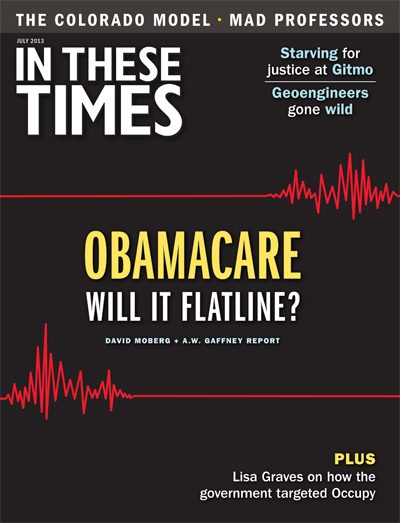
There are five of us in the entire theater. That includes my mother and my stepfather, whom I dragged to this desolate strip mall in Miami, an hour south of my mom’s house, on a Sunday. The Palace 18 is one of a few cinemas in the whole country playing Hating Breitbart, a documentary that I felt compelled to see because, ostensibly, it’s about lefties like me who loathed the right-wing punk, now deceased, for whom the film is named.Though the worn Miami multiplex is respectable enough, Hating Breitbart is being shown in an auditorium with only a few dozen seats, the aisles patched with outdated powder-blue linoleum squares. Unlike the studio features, which have full-color title cards above the theater doors, Hating Breitbart is marked by a generic sign spun off of an inkjet.
When we walk in, two men are chatting in their seats. They’re Breitbart fanatics, waiting for their fix like perverts in a porn theater. The tall one is wearing an ill-fitting grey suit with a flag lapel pin; the shorter schlub, in the next row, has a dated butt-cut hairdo. They just met, but are already trading conspiracy theories about Breitbart’s demise. The 43-year-old shock pundit died from heart failure in March 2012, but some believe that he was rubbed out by freedom-hating Democrats. No joke — Buzzfeed floated a post of “25 People Who Think President Obama Killed Andrew Breitbart.”
As I’m about to chime in with a murder scenario involving George Soros in the study with the candlestick, the place goes black, and I’m suddenly looking at a quote from Thomas Jefferson that fills the screen: “Nothing can now be believed which is seen in a newspaper.” The trope is classic Breitbart; though the firebrand helped found the Drudge Report and the Huffington Post—as well as his own far-right rhetorical circus, Breitbart.com — he preached that all news outlets were essentially evil, and he went to the edge of the earth to expose what he considered media bias.
Shot in the two years before its subject’s death, Hating Breitbart is geared to roundly dismiss charges that he was a sexist and bigot. With no narration or organization, director Andrew Marcus does this by lazily interspersing interviews — mostly with those who considered Breitbart a deity — among footage from the protagonist’s marquee donnybrooks with such nemeses as Shirley Sherrod, a state director with the Department of Agriculture who was forced to resign after Breitbart publicized a doctored tape in which she appeared to disparage white people.
Hating Breitbart will raise concerns for anyone who thinks facts are a component of documentaries. For example, the movie sees a clear conservative victory in the takedown of ACORN, the national social justice network that was targeted and then obliterated by Breitbart and his khaki-clad videographer compadre James O’Keefe. Posing activist Hannah Giles as a scantily clad prostitute and looking for guidance on how to smuggle girls across the border, O’Keefe taped ACORN employees on both coasts giving compromising advice.
Details are ignored here. There’s no mention that O’Keefe and Giles have since paid in excess of $100,000 to an ACORN employee whom they misrepresented. And despite insinuation via Broll that O’Keefe presented himself like Super Fly, he never actually dressed like a pimp inside of ACORN offices.
Baloney aside, one thing that’s not overlooked is Giles, whose skimpy getups receive extraordinary attention from Marcus. Anyone who’s had difficulty comprehending the obsession right-wing codgers have with the ACORN videos will understand sometime between the clip in which Giles strolls at the camera with stilettos kicking high and the alley shot of her pressed against a chain link fence in a miniskirt.
The recurring echoes of soft-core smut are uncomfortable, given that I’m watching the film with my mom. It doesn’t help when Giles straddles the screen in one shot, and I turn back to find the Breitbart groupie with the butt-cut grinning like a stoner at Friendly’s. The other one — an odd and boney caricature patriot — is similarly creepy.
For all the fluff and fantasy about Breitbart being a vehicle of truth, there is some insight into this callous beast. Though it’s well-known that Breitbart’s father-in-law was legendary Hollywood conservative Orson Bean, interviews here show the obvious impact that Bean had in turning Breitbart into a flame-spitting right-wing entertainer. Perhaps as revealing: Bean’s wife, Alley Mills, played the mom on The Wonder Years, the quintessential television program about the halcyon days of apple pie America that Tea Partiers pine for.
Unless you are one of the geeks who follow the partisan blogosphere like a professional sport, Hating Breitbart is a waste of time. I’m a nerd for this stuff, but by the one-hour mark I was shoving popcorn in my ears to blunt Breitbart’s irksome intonation, waiting for him to croak.
There’s been a lot of talk about the collapse of Breitbart’s empire, and the demise of the Tea Party. I’m not so sure about either; as we’ve seen in the midst of the so-called IRS scandal, right-wing radicals who feel targeted by government forces are back to holding silly signs in public places. But after viewing Hating Breitbart in an empty closet at the Palace 18 — in the heart of Marco Rubio country, no less — I’m certain of one thing: The next Right revolution won’t transpire through cinema.





